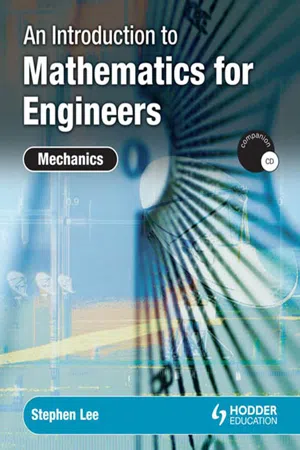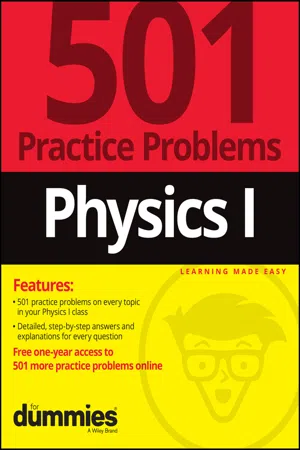Mathematics
Angular Speed
Angular speed refers to the rate at which an object rotates around a fixed point. It is measured in radians per unit of time, such as radians per second. Angular speed is a key concept in trigonometry and calculus, and it is used to calculate the rotational motion of objects in various mathematical and physical contexts.
Written by Perlego with AI-assistance
Related key terms
1 of 5
12 Key excerpts on "Angular Speed"
- eBook - PDF
- Cynthia Y. Young(Author)
- 2021(Publication Date)
- Wiley(Publisher)
3.3.2 Conceptual Understand that Angular Speed has units of radians/time. To calculate linear speed, we find how fast a position along the circumference of a circle is changing. To calculate Angular Speed, we find how fast the central angle is changing. 142 CHAPTER 3 Radian Measure and the Unit Circle Approach Video EXAMPLE 2 Angular Speed s A lighthouse in the middle of a channel rotates its light in a circular motion with constant speed. If the beacon of light completes one rotation every 10 seconds, what is the Angular Speed of the beacon in radians per minute? Solution Calculate the angle measure in radians associated with one rotation. θ = 2π Substitute θ = 2π and t = 10 seconds ω = 2π (rad) _______ 10 sec into ω = θ __ t . Convert the Angular Speed from radians per second to radians per minute. ω = 2π (rad) _______ 10 sec · 60 sec ______ 1 min Simplify. ω = 12π rad/min Your Turn If the lighthouse in Example 2 is adjusted so that the beacon rotates one time every 40 seconds, what is the Angular Speed of the beacon in radians per minute? Answer ω = 3π rad/min Angular Speed If a point P moves along the circumference of a circle at a constant speed, then the central angle θ that is formed with the terminal side passing through point P also changes over some time t at a constant speed. The Angular Speed ω (omega) is given by ω = θ __ t where θ is given in radians STUDY TIP The units of Angular Speed will be in radians per unit time (e.g., radians per minute). Concept Check If we know that it takes a beacon, A minutes to complete one full rotation then what is its Angular Speed? Answer: 2π ___ A rad/min 3.3.3 Relationship Between Linear and Angular Speeds 3.3.3 Skill Solve application problems involving both angular and linear speeds. 3.3.3 Conceptual Understand that Angular Speed and linear speed are related through the radius. - eBook - ePub
Doing Physics with Scientific Notebook
A Problem Solving Approach
- Joseph Gallant(Author)
- 2012(Publication Date)
- Wiley(Publisher)
Evaluate Numerically to find the number of times the record turns while it’s slowing down.The record turns about 2.8 times while it’s slowing down.When the angular acceleration is not constant, you must use calculus to describe the object’s rotational motion. The angular velocity is the rate of change of the angular displacement.(7.9)If you know the angular position as a function of time, you can calculate the Angular Speed.The angular acceleration is the rate of change of Angular Speed.(7.10)If you know the Angular Speed as a function of time, you can calculate the angular acceleration. From these definitions we can derive four basic equations which describe the angular position and speed of objects rotating with a varying acceleration.(7.11a)(7.11b)(7.11c)(7.11d)For varying angular acceleration, the average angular velocity does not equal the arithmetic average of the initial and final angular velocities.The Compact Disk
The rotational motion of a CD is an excellent example of nonuniform rotational motion with a time-dependent acceleration. To read the information on a record, a needle starts at the outer edge and follows a single spiral track while the disk rotates at a constant Angular Speed. To read the information on a CD, a laser starts at the inner radius and follows a single spiral track while the disk rotates at a decreasing Angular Speed. This ensures the data-read rate, which is proportional to the linear speed, is constant. [31]The data on a typical CD is stored between R0 = 2.3 cm and Rf = 5.8 cm, and the spacing between tracks is Δr = 1.6 μm/rev. We can use Evaluate Numerically - eBook - PDF
- Paul A. Calter, Michael A. Calter(Authors)
- 2011(Publication Date)
- Wiley(Publisher)
The units of angular velocity are degrees, radians, or revolutions, per unit time. Angular Displacement The angle through which a body rotates in time t is called the angular displacement. It is related to and t by the following equation: Angular Displacement 1026 The angular displacement is the product of the angular velocity and the elapsed time. u vt v u v cos D sin L 1 sin L 2 cos L 1 cos L 2 cos(M 1 M 2 ) rs/2, u s> r , area r 2 u/2 u 1 4 60° s A(r 0.4t)p 180 15°2505 28.3°. 3.75 in. Pitch circle 41.6° R FIGURE 14–18 Sector gear. 28.5 cm B A FIGURE 14–17 s r A 0.4t t FIGURE 14–19 Bending allowance. r V 0 ω FIGURE 14–20 Rotating body. The symbol is lowercase Greek omega, not the letter w. v Section 3 ◆ Uniform Circular Motion 417 This equation is similar to our old formula ( ) for linear motion. ◆◆◆ Example 23: A wheel is rotating with an angular velocity of 1800 rev/min. How many revolutions does the wheel make in 1.5 s? Solution: We first make the units of time consistent. Converting yields Then, by Eq. 1026, ◆◆◆ ◆◆◆ Example 24: Find the angular velocity in revolutions per minute of a pulley that rotates in 0.750 s. Solution: By Eq. 1026, Converting to rev/min, we obtain ◆◆◆ ◆◆◆ Example 25: How long will it take a spindle rotating at 3.55 rad/s to make 1000 revolutions? Solution: Converting revolutions to radians, we get Then, by Eq. 1026, ◆◆◆ Linear Speed For any point on a rotating body, the linear displacement per unit time along the cir- cular path is called the linear speed. The linear speed is zero for a point at the cen- ter of rotation and is directly proportional to the distance r from the point to the center of rotation. If is expressed in radians per unit time, the linear speed is given by the following equation: Linear Speed 1027 The linear speed of a point on a rotating body is equal to the angular velocity of the body times the distance of the point from the center of rotation. - eBook - PDF
- Stephen Lee(Author)
- 2014(Publication Date)
- CRC Press(Publisher)
, and d d 2 t 2 as .. . Figure 12.1 shows a particle P moving round the circumference of a circle of radius r , centre O. At time t , the position vector OP ⎯→ of the particle makes an angle (in radians) with the fixed direction OA ⎯→ . The arc length AP is denoted by s . Figure 12.1 12.2 Angular Speed Using this notation, s r . Differentiating this with respect to time using the product rule gives: d d s t r d d t d d r t . Since r is constant for a circle, d d r t 0, so the rate at which the arc length increases is: d d s t r d d t or s . r . . In this equation s . is the speed at which P is moving round the circle (often denoted by v ), and . is the rate at which the angle is increasing, i.e. the rate at which the position vector OP ⎯→ is rotating. The quantity d d t , or . , can be called the angular velocity or the Angular Speed of P. In more advanced work, angular velocity is treated as a vector, whose direction is taken to be that of the axis of rotation. In this chapter, d d t is often referred to as Angular Speed, but is given a sign: positive when is increasing (usually anticlockwise) and negative when is decreasing (usually clockwise). ➀ O P r s θ A CIRCULAR MOTION 253 Angular Speed is often denoted by , the Greek letter omega. So the equation s . r . may be written as v r . Notice that for this equation to hold, must be measured in radians, so the Angular Speed is measured in radians per second or rad s 1 . Figure 12.2 shows a disc rotating about its centre, O, with Angular Speed . The line OP represents any radius. Figure 12.2 Every point on the disc describes a circular path, and all points have the same Angular Speed. However the actual speed of any point depends on its distance from the centre: increasing r in the equation v r increases v . You will appreciate this if you have ever been at the end of a rotating line of people in a dance or watched a body of marching soldiers wheeling round a corner. - eBook - PDF
- David Halliday, Robert Resnick, Jearl Walker(Authors)
- 2021(Publication Date)
- Wiley(Publisher)
● The linear velocity v → of the point is tangent to the circle; the point’s linear speed v is given by v = ωr (radian measure), where ω is the Angular Speed (in radians per second) of the body, and thus also the point. ● The linear acceleration a → of the point has both tangential and radial components. The tangential component is a t = αr (radian measure), where α is the magnitude of the angular acceleration (in radians per second-squared) of the body. The radial component of a → is a r = v 2 _ r = ω 2 r (radian measure). ● If the point moves in uniform circular motion, the period T of the motion for the point and the body is T = 2πr _ v = 2π _ ω (radian measure). Relating the Linear and Angular Variables In Module 4.5, we discussed uniform circular motion, in which a particle travels at constant linear speed v along a circle and around an axis of rotation. When a rigid body, such as a merry-go-round, rotates around an axis, each particle in the body Additional examples, video, and practice available at WileyPLUS 282 CHAPTER 10 ROTATION moves in its own circle around that axis. Since the body is rigid, all the particles make one revolution in the same amount of time; that is, they all have the same Angular Speed ω. However, the farther a particle is from the axis, the greater the circumference of its circle is, and so the faster its linear speed v must be. You can notice this on a merry-go-round. You turn with the same Angular Speed ω regardless of your distance from the center, but your linear speed v increases noticeably if you move to the outside edge of the merry-go-round. We often need to relate the linear variables s, v, and a for a particular point in a rotating body to the angular variables θ, ω, and α for that body. The two sets of variables are related by r, the perpendicular distance of the point from the rotation axis. This perpendicular distance is the distance between the point and the rotation axis, measured along a perpendicular to the axis. - eBook - ePub
- William Bolton(Author)
- 2012(Publication Date)
- Routledge(Publisher)
The instantaneous angular velocity ω is the change in angular displacement with time when the time interval tends to zero. It can be expressed as:
3 Angular accelerationThe average angular acceleration over some time interval is the change in angular velocity during that time divided by the time:[20] [21] The unit is rad/s2 . The instantaneous angular acceleration a is the change in angular velocity with time when the time interval tends to zero. It can be expressed as:[22] 4.4.1 Motion with constant angular accelerationFor a body rotating with a constant angular acceleration α, when the angular velocity changes uniformly from ω0 to co in time t, as in Figure 4.19 , equation [21 ] gives:Figure 4.19 Uniformly accelerated motionand hence:ω = ω0 + at [23] The average angular velocity during this time is ½(ω + ω0 ) and thus if the angular displacement during the time is θ:Substituting for co using equation [23 ]:Hence:θ = ω0 t + ½at2 [24] Squaring equation [23 ] gives:Hence, using equation [24 ]:[25] ExampleAn object which was rotating with an angular velocity of 4 rad/s is uniformly accelerated at 2 rad/s. What will be the angular velocity after 3 s?Using equation [23 ]:ω = ω0 + at = 4 + 2 × 3 = 10 rad/sExampleThe blades of a fan are uniformly accelerated and increase in frequency of rotation from 500 to 700 rev/s in 3.0 s. What is the angular acceleration?Since ω = 2πf, equation [23 ] gives:2π × 700 = 2π × 500 + a × 3.0Hence a = 419 rad/s2 .ExampleA flywheel, starting from rest, is uniformly accelerated from rest and rotates through 5 revolutions in 8 s. What is the angular acceleration?The angular displacement in 8 s is 2π × 5 rad. Hence, using equation [24 ], i.e. θ = ω0 t + ½at2 :2π × 5 = 0 + ½a × 82Hence the angular acceleration is 0.98 rad/s2 .Revision13 A flywheel rotating at 3.5 rev/s is accelerated uniformly for 4 s until it is rotating at 9 rev/s. Determine the angular acceleration and the number of revolutions made by the flywheel in the 4 s. - eBook - PDF
- John D. Cutnell, Kenneth W. Johnson, David Young, Shane Stadler(Authors)
- 2015(Publication Date)
- Wiley(Publisher)
Your extended thumb points along the axis in the direction of the angular velocity vector. No part of the rotating object moves in the direction of the angular velocity vector. Angular acceleration arises when the angular velocity changes, and the acceleration vector also points along the axis of rotation. The acceleration vector has the same direction as the change in the angular velocity. That is, when the magnitude of the angular velocity (which is the Angular Speed) is increasing, the angular acceleration vector points in the same direction as the angular velocity. Conversely, when the magnitude of the angular velocity is decreasing, the angular acceleration vector points in the direction opposite to the angular velocity. Right hand Right hand v v Figure 8.15 The angular velocity vector B v of a rotating object points along the axis of rotation. The direction along the axis depends on the sense of the rotation and can be determined with the aid of a right-hand rule (see the text). CONCEPT SUMMARY 8.1 Rotational Motion and Angular Displacement When a rigid body rotates about a fixed axis, the angular displacement is the angle swept out by a line passing through any point on the body and intersecting the axis of rotation perpendicularly. By convention, the angular displacement is positive if it is counterclockwise and negative if it is clockwise. The radian (rad) is the SI unit of angular displacement. The angle u in radians is defined in Equa- tion 8.1 as the circular arc of length s traveled by a point on the rotating body divided by the radial distance r of the point from the axis. 8.2 Angular Velocity and Angular Acceleration The average angular velocity v is the angular dis- placement Du divided by the elapsed time Dt, according to Equation 8.2. As Dt approaches zero, the average angular velocity becomes equal to the instantaneous angular velocity v. The magnitude of the instantaneous angular velocity is called the instantaneous Angular Speed. - eBook - PDF
- Raymond A. Barnett, Michael R. Ziegler, Karl E. Byleen(Authors)
- 2012(Publication Date)
- Wiley(Publisher)
2. Explain the meaning of angular velocity for a point mov- ing on the circumference of a circle. 3. A point moves on the circumference of a circle at 100 radians per second. Is this a linear velocity or an angular velocity? Explain. 4. A car travels around a circular race track at 185 miles per hour. Is this a linear velocity or an angular velocity? Explain. In Problems 5–8, use the indicated information to find the velocity V of a point on the rim of a wheel. 5. 6. 7. 8. In Problems 9–12, use the indicated information to find the angular velocity v. 9. 10. 11. 12. In Problems 13–16, find the angular velocity of a wheel turn- ing through u radians in time t. 13. 14. 15. 16. 17. Explain the concept of a mean solar day. 18. Explain the concept of a mean sidereal day. Applications 19. Engineering A 16 mm diameter shaft rotates at 1,500 rps (revolutions per second). Find the speed of a point on its surface (to the nearest meter per second). t = 12.9 sec u = 4.75 rad, t = 1.53 min u = 9.62 rad, t = 22.0 sec u = 5p rad, t = 0.056 hr u = 3p rad, V = 355 cm> sec r = 125 cm, V = 210 m> min r = 98 m, V = 90 ft> sec r = 8.0 ft, V = 1,950 mi> hr r = 250 mi, v = 145 rad> hr r = 0.567 km, v = 200 rad> hr r = 1.2 ft, v = 0.07 rad> sec r = 125 mm, v = 0.7 rad> min r = 12 cm, 20. Engineering A 6 cm diameter shaft rotates at 500 rps. Find the speed of a point on its surface (to the nearest meter per second). 21. Space Science An earth satellite travels in a circular orbit at 20,000 mph. If the radius of the orbit is 4,300 mi, what angular velocity (in radians per hour, to three sig- nificant digits) is generated? 22. Engineering A bicycle is ridden at a speed of 7.0 m>sec. If the wheel diameter is 64 cm, what is the angular veloc- ity of the wheel in radians per second? 23. Physics The velocity of sound in air is approximately 335.3 m>sec. If an airplane has a 3.000 m diameter pro- peller, at what angular velocity will its tip pass through the sound barrier? 24. - (Author)
- 2022(Publication Date)
- For Dummies(Publisher)
The minus sign indicates that this acceleration is in the direction opposite the direction of the ini-tial velocity. You accelerate for t 2 6 . seconds. Plug these quantities into the equation for angular displacement to find i i m s m s rad/ s t t v r t t 1 2 1 2 22 0 37 2 6 1 2 7 3 2 2 2 2 / . . . ( . 6 130 2 s rad ) 196. 0.19 rad/s Your angular acceleration is a r where a 3 4 . meters per second per second is your tangential acceleration and r 25 meters is the radius of the curved part of the track. Angular velocity is related to angular acceleration by t where f i is your change in Angular Speed and t 1 4 . seconds is the time over which you acceler-ate. For this problem, the initial speed is i 0 radians per second. Combining these two equations and plugging in the known quantities gives t a r t a r t f i f m s m s rad/s 3 4 25 1 4 0 19 2 . / . . 236 PART 2 The Answers ANSWERS 101–200 197. 0.015 m/s 2 First, convert the given quantities to meters and seconds. The time it takes to complete the turn is t 12 60 1 720 min s min s The radius of the turn is r 0 50 1609 1 804 5 . . mi m mi m The Angular Speed of the boat is t where radians because there are radians in 180 degrees. Express the centripetal acceleration in terms of the Angular Speed using v r and a v r 2 . Combining these two equations and the equation above for Angular Speed gives a v r r r r t r 2 2 2 2 ( ) Insert the known quantities: a t r 2 2 2 720 804 5 0 015 rad s m m/s . . 198. 20 m/s 2 The tangential speed of the tip of the lasso is v r where 3 8 . radians per second is the Angular Speed and r 1 4 . meters is the radial distance from the center of the circle (that is, your hand) to the tip of the lasso. The centripetal acceleration is a v r r r r 2 2 2 ( ) CHAPTER 16 Answers 237 ANSWERS 101–200 Plug in the known quantities to find a r 2 2 2 3 8 1 4 20 ( . / ) . rad s m m/s 199. 0.32 m The maximum centripetal acceleration is a 3 8 .- Raymond Serway, John Jewett(Authors)
- 2018(Publication Date)
- Cengage Learning EMEA(Publisher)
Equation 10.10 shows that the tangential speed of a point on the rotat- ing object increases as one moves outward from the center of rotation, as we would intuitively expect. For example, the outer end of a swinging golf club moves much faster than a point near the handle. We can relate the angular acceleration of the rotating rigid object to the tangen- tial acceleration of the point P by taking the time derivative of v in Equation 10.10: a t 5 dv dt 5 r dv dt a t 5 r a (10.11) That is, the tangential component of the translational acceleration of a point on a rotating rigid object equals the point’s perpendicular distance from the axis of rotation multiplied by the angular acceleration. In Section 4.4, we found that a point moving in a circular path undergoes a radial acceleration a r directed toward the center of rotation and whose magnitude is that of the centripetal acceleration v 2 / r (Fig. 10.5). Because v 5 rv for a point P on a rotating object, we can express the centripetal acceleration at that point in terms of Angular Speed as we did for a particle moving in a circular path in Equation 4.25: a c 5 v 2 r 5 r v 2 (10.12) The total acceleration vector at the point is a S 5 a S t 1 a S r , where the magnitude of a S r is the centripetal acceleration a c . Because a S is a vector having a radial and a tan- gential component, the magnitude of a S at the point P on the rotating rigid object is a 5 Ïa t 2 1 a r 2 5 Ïr 2 a 2 1 r 2 v 4 5 r Ïa 2 1 v 4 (10.13) Q UICK QUIZ 10.3 Ethan and Rebecca are riding on a merry-go-round. Ethan rides on a horse at the outer rim of the circular platform, twice as far from the center of the circular platform as Rebecca, who rides on an inner horse.- eBook - PDF
Mechanotechnics N6 Student's Book
TVET FIRST
- Sparrow Consulting(Author)
- 2021(Publication Date)
- Macmillan(Publisher)
221 Kinematics TVET FIRST 2. The angular acceleration: Step 1: Calculate the angular velocity (if you used Eq. 8.4) ω = v _ r = 60 _ 20 = 3 rad/s Step 2: Calculate the angular acceleration using Eq. 8.1 α = Δω _ Δt = 3 _ 30 = 0, 1 rad/s 2 8.3.2 Angular acceleration Angular acceleration is the rate of change of angular velocity. It is calculated using: α = Δω _ Δt [Eq. 8.7] Where: ∆ω = change in angular velocity [rad/s] ∆t = change in time [s] The angular acceleration is therefore given as: α = ω f − ω i _ t f − t i Where: ω f = final angular velocity [rad/s] ω i = initial angular velocity [rad/s] t f = final time [s] t i = initial time [s] Note If both angular velocity and acceleration are positive or negative (directed in the same direction), then the speed of the object increases. If the angular velocity has a different sign to the angular acceleration (directed in the opposite direction), then the object’s speed decreases. Example 8.7 A wheel of a vehicle rotates in a clockwise direction. Determine the angular acceleration and draw the direction of angular acceleration if: 1. The wheel starts at rest and rotates up to a speed of 45 rad/s in 10 s. 2. The wheel slows down from 60 rad/s to 25 rad/s in 8 s. Solution 1. The wheel starts at rest and rotates up to a speed of 45 rad/s in 10 s: α = ω f − ω i _ t f − t i = 45 − 0 _ 10 − 0 = 4, 5 rad/s 2 The wheel rotates clockwise. The angular acceleration is also directed in a clockwise direction at 4,5 rad/s 2 because the sign is positive (see Figure 8.52). Figure 8.52: Angular acceleration of the wheel α 222 Module 8 TVET FIRST 2. The wheel slows down from 60 rad/s to 25 rad/s in 8 s: α = ω f − ω i _ t f − t i = 25 − 60 _ 8 − 0 = − 4, 375 rad/s 2 The wheel rotates in a clockwise direction. However, because the angular acceleration is a negative sign, it is accelerating in an anticlockwise direction at 4,375 rad/s 2 (see Figure 8.53). - No longer available |Learn more
Physics for Scientists and Engineers
Foundations and Connections, Extended Version with Modern Physics
- Debora Katz(Author)
- 2016(Publication Date)
- Cengage Learning EMEA(Publisher)
The distance traveled is directly proportional to r, the distance from the particle to the axis of rotation. Expressed mathematically, d 5 1Du 2 r (12.12) where Du is measured in radians. In SI units, both d and r are measured in meters, showing again that radians are dimensionless. Translational Velocity of a Point on a Rotating Object Now let us look at the translational and Angular Speeds of Sophia’s nose and shoe. Sophia moves from her initial position to her final position in a time interval Dt . Her nose and shoe undergo the same angular displacement Du in the same time interval. Therefore, her nose and shoe have the same average Angular Speed v av 5 Du / Dt (Eq. 12.3), and if we consider an infinitesimal angular displacement du in an infini- tesimal time interval dt, her nose and shoe have identical instantaneous Angular Speeds v 5 du / dt (Eq. 12.4). You already know that all particles of a rotating rigid object have the same an- gular speed v, but you may be surprised to learn that not all the particles have the same translational speed. Sophia’s shoe travels a greater distance than her nose in the same time interval, so her shoe must be moving at a higher average speed than her nose: v av, shoe 5 d shoe Dt and v av, nose 5 d nose Dt Using d 5 r 1Du 2 (Eq. 12.12) for distance traveled, v av, shoe 5 r shoe Du Dt and v av, nose 5 r nose Du Dt Final position Initial position a shoe = a nose v shoe = v nose Du shoe = Du nose v shoe > v nose a c, shoe > a c, nose a T, shoe > a T, nose Du Du r nose r shoe d shoe d nose FIGURE 12.15 Sophia in rotation is modeled as a rigid object, so her nose and her shoe have equal angular displacements ∆u, Angular Speeds v , and angular accelerations a. Her shoe is farther from the axis of rotation than her nose is. Therefore, the translational parameters d, v, a T , and a c of her shoe are greater than those for her nose. Copyright 2017 Cengage Learning. All Rights Reserved.
Index pages curate the most relevant extracts from our library of academic textbooks. They’ve been created using an in-house natural language model (NLM), each adding context and meaning to key research topics.











